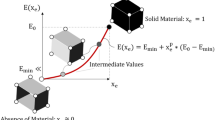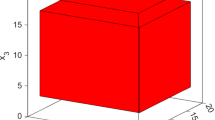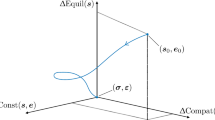Abstract
Aim of the present study is to propose an enhanced method for the domain decomposition (clustering) of the representative volume element (RVE) of composite materials to be used with homogenization techniques, based on the PieceWise Uniform Transformation Field Analysis (PWUTFA). With PWUTFA, both constitutive and evolutive equations for the constituents of the composite material are written in terms of averages in each cluster; moreover, it is not required to solve via FEM the nonlinear micro-mechanical problem, allowing to drastically reduce the number of internal variables. PWUTFA is founded on the idea that it is possible to divide the RVE into large subdomains (clusters) that should group together finite elements having, under any applied loading condition, the most similar values of strain. Accordingly, in this study a multi-objective optimization-based approach is proposed with the aim to simultaneously reduce both the error in the approximation of the strain fields and the number of clusters in which the domain is decomposed. Different clustering solutions, obtained through the proposed optimization approach are analyzed, and the corresponding mechanical responses are compared with the ones obtained by the finite element analysis and by uniform transformation field analysis.




























Similar content being viewed by others
References
Chaboche JL, Kanouté P, Roos A (2005) On the capabilities of mean-field approaches for the description of plasticity in metal matrix composites. Int J Plast 21(7):1409–1434
Covezzi F, de Miranda S, Marfia S, Sacco E (2016) Complementary formulation of the TFA for the elasto-plastic analysis of composites. Compos Struct 156:93–100
Covezzi F, de Miranda S, Marfia S, Sacco E (2017) Homogenization of elastic–viscoplastic composites by the mixed TFA. Comput Methods Appl Mech Eng 318:701–723
de Souza Neto EA, Perić D, Owen DRJ (2008) Computational methods for plasticity: theory and applications. Wiley, New York
Dvorak GJ (1992) Transformation field analysis of inelastic composite materials. Proc R Soc Lond A 437:311–327
Dvorak GJ, Bahei-El-Din A (1997) Inelastic composite materials: transformation field analysis and experiments. In: Suquet P (ed) Continuum micromechanics, CISM course and lecture, vol 377. Springer, Vienna, pp 1–59
Franciosi P, Berbenni S (2007) Heterogeneous crystal and poly-crystal plasticity modeling from transformation field analysis within a regularized Schimd law. J Mech Phys Solids 55:2265–2299
Franciosi P, Berbenni S (2008) Multi-laminate plastic-strain organization for nonuniform TFA modeling of poly-crystal regularized plastic flow. Int J Plast 24:1549–1580
Fritzen F, Hodapp M, Leuschner M (2014) GPU accelerated computational homogenization based on a variational approach in a reduced basis framework. Comput Methods Appl Mech Eng 278:186–217
Fritzen F, Leuschner M (2013) Reduced basis hybrid computational homogenization based on a mixed incremental formulation. Comput Methods Appl Mech Eng 260:143–154
Fritzen F, Leuschner M (2015) Nonlinear reduced order homogenization of materials including cohesive interfaces. Comput Mech 56(1):131–151
Gunst RF (1996) Response surface methodology: process and product optimization using designed experiments. Technometrics 38(3):284–286. https://doi.org/10.1080/00401706.1996.10484509
Liu Z, Bessa MA, Liu WK (2016) Self-consistent clustering analysis: an efficient multi-scale scheme for inelastic heterogeneous materials. Comput Methods Appl Mech Eng 306:319–341
MathWorks Inc. Matlab software. https://ch.mathworks.com/products/matlab.html. January 2019
Marfia S, Sacco E (2016) Computational homogenization of composites experiencing plasticity, cracking and debonding phenomena. Comput Methods Appl Mech Eng 304:319–341
Marfia S, Sacco E (2018) Multiscale technique for nonlinear analysis of elastoplastic and viscoplastic composites. Compos Part B 136:241–253
Michel JC, Suquet P (2003) Nonuniform transformation field analysis. Int J Solids Struct 40:6937–6955
Michel JC, Suquet P (2004) Computational analysis of nonlinear composite structures using the nonuniform transformation field analysis. Comput Methods Appl Mech Eng 193:5477–5502
Perzyna P (1968) Fundamental problems in viscoplasticity. Adv Appl Mech 9(1):243–377
Roussette S, Michel JC, Suquet P (2009) Nonuniform transformation field analysis of elastic–viscoplastic composites. Compos Sci Technol 69:22–27
Seber George AF (2009) Multivariate observations, vol 252. Wiley, New York
Sepe V, Marfia S, Sacco E (2013) A nonuniform TFA homogenization technique based on piecewise interpolation functions of the inelastic field. Int J Solids Struct 50:725–742
Ward JH Jr, Joe H (1963) Hierarchical grouping to optimize an objective function. J Am Stat Assoc 58(301):236–244
Wulfinghoff S, Cavaliere F, Reese S (2018) Model order reduction of nonlinear homogenization problems using a hashin-shtrikman type finite element method. Comput Methods Appl Mech Eng 330:149–179
Acknowledgements
This study was funded by Italian Ministry of Education, Project PRIN2015 Multi-scale mechanical models for the design and optimization of micro-structured smart materials and metamaterials (CUP H32F15000090005) and Project PRIN2017 3D Printing: a bridge to the future: computational methods, innovative applications, experimental validations of new materials and technologies (CUP Project number 2017L7X3CS) that is gratefully acknowledged. This work was also partially supported by Regione Lombardia through the Project MADE4LO - Metal ADditivE for LOmbardy (No. 240963) within the POR FESR 2014–2020 program.
Author information
Authors and Affiliations
Corresponding author
Additional information
Publisher's Note
Springer Nature remains neutral with regard to jurisdictional claims in published maps and institutional affiliations.
Rights and permissions
About this article
Cite this article
Alaimo, G., Auricchio, F., Marfia, S. et al. Optimization clustering technique for PieceWise Uniform Transformation Field Analysis homogenization of viscoplastic composites. Comput Mech 64, 1495–1516 (2019). https://doi.org/10.1007/s00466-019-01730-2
Received:
Accepted:
Published:
Issue Date:
DOI: https://doi.org/10.1007/s00466-019-01730-2




